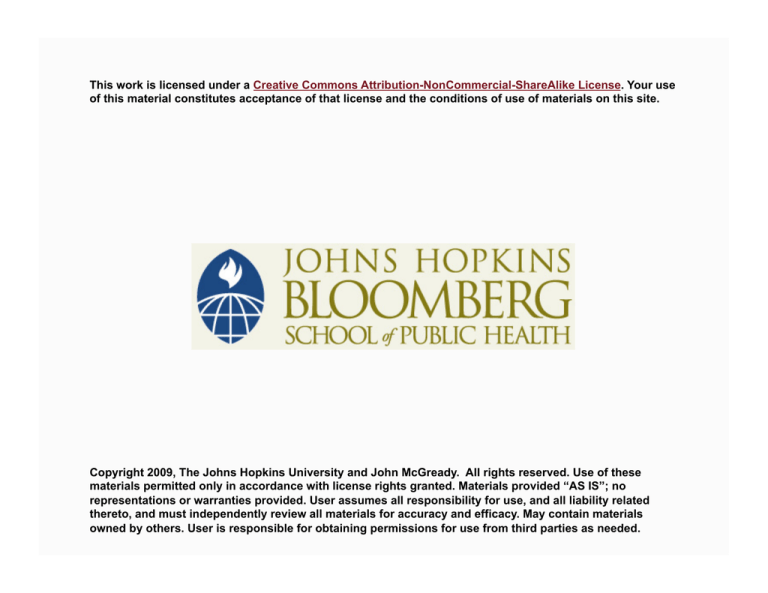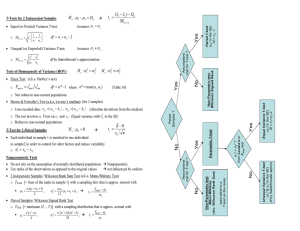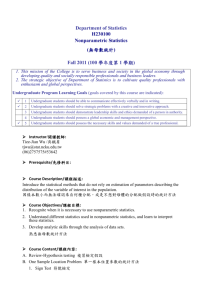
This work is licensed under a Creative Commons Attribution-NonCommercial-ShareAlike License. Your use
of this material constitutes acceptance of that license and the conditions of use of materials on this site.
Copyright 2009, The Johns Hopkins University and John McGready. All rights reserved. Use of these
materials permitted only in accordance with license rights granted. Materials provided “AS IS”; no
representations or warranties provided. User assumes all responsibility for use, and all liability related
thereto, and must independently review all materials for accuracy and efficacy. May contain materials
owned by others. User is responsible for obtaining permissions for use from third parties as needed.
Section F (Optional)
Non-Parametric Analogue to the Two Sample t-test
Alternative to the Two Sample T-Test
Nonparametric test for comparing two groups
“Non-parametric” refers to a class of tests that do not assume
anything about distribution of the data
Nonparametric test for comparing two groups
- Mann-Whitney Rank Sum Test (Wilcoxon Rank Sum Test)
- Also called Mann-Whitney-Wilcoxon (a mouthful)
Tries to answer the following question:
- Are the two population distributions different?
3
Advantages
Does not assume populations being compared are normally
distributed
- The two-sample t-test requires that assumption with very small
samples sizes
Uses only ranks
Not sensitive to outliers
4
Disadvantage of the Nonparametric Test
Nonparametric methods are often less sensitive (powerful) for
finding true differences because they throw away information (they
use only ranks)
Need full data set, not just summary statistics
Results do not include any confidence intervals quantifying range of
possibility for true difference between populations
5
Example: Health Education Study
Evaluate an intervention to educate high school students about
health and lifestyle over a two-month period
10 students randomized to “intervention” or “control” group
x = post test score – pre-test score is outcome to compare between
the intervention and control groups
6
Example: Health Education Study
x = post- pretest score for both groups
Intervention (I)
Control (C)
6
-5
-6
1
4
- Only five individuals in each sample!!!
- We want to compare the control and intervention groups to
assess whether the “improvement” (post–pre) in scores are
different, taking random sampling error into account
5
0
7
2
19
7
Example: Health Education Study
With such a small sample size, we need to be sure score
improvements are normally distributed if we want to use
t-test (BIG assumption)
Possible approach:
- Mann-Whitney-Wilcoxon non-parametric test!
8
Example: Health Education Study
First step—rank the pooled data (ignore groupings)
-
Rank
-6 -5 0 1 2 4 5 5 7 19
1 2 3 4 5 6 7 8 9 10
9
Example: Health Education Study
Second step—“reattach” group status
-
-
Rank
Group
-6 -5 0 1 2 4 5 5 7 19
1 2 3 4 5 6 7 8 9 10
C C I C I C I C I
I
10
Example: Health Education Study
Find the average rank in each of the two groups
Intervention group average rank
Control group average rank
11
Example: Health Education Study
Statisticians have developed formulas and tables to determine the
probability of observing such an extreme discrepancy in ranks (6.8
vs. 4.2) by chance alone
- This is the p-value
In the health education study, the p-value was .17
- The interpretation is that the Mann-Whitney test did not show
any significant difference in test score “improvement” between
the intervention and control group (p = .17)
12
Notes
The two-sample t-test would give a different answer (p = .14)
Different statistical procedures can give different p-values
If the largest observation, 19, was changed, the p-value based on
the Mann-Whitney test would not change but the two-sample t-test
would change
13
Notes
The t-test or the nonparametric test?
- Statisticians will not always agree, but there are some
guidelines
- Use non-parametric test if sample size is small and you have no
reason to believe data is “well behaved” (normally distributed)
- Only “ranks” available
14
Using Stata to Perform Mann-Whitney-Wilcoxon
Data, as entered
15
Using Stata to Perform Mann-Whitney-Wilcoxon
“ranksum” command
- Syntax:
ranksum varname, by(group_var)
16
Using Stata to Perform Mann-Whitney-Wilcoxon
“ranksum” command
- Syntax:
ranksum varname, by(group_var)
17
Using Stata to Perform t-test
“ttest” command without “i” on end when data already in Stata
- Syntax:
ttest varname, by(group_var)
18
Summary: Educational Intervention Example
Statistical methods
- 10 high school students were randomized to either receive a
two-month health and lifestyle education program (or no
program)
- Each student was administered a test regarding health and
lifestyle issues prior to randomization (and after the two-month
period)
19
Summary: Educational Intervention Example
Statistical methods
- Differences in the two test scores (after-before) were computed
for each student
- Mean and median test score changes were computed for each of
the two study groups
- A Mann-Whitney rank sum test was used to determine if there
was a statistically significant difference in test score change
between the intervention and control groups at the end of the
two-month study period
20
Summary: Educational Intervention Example
Result
- Participants randomized to the educational intervention scored
a median five points higher on the test given at the end of the
two-month study period, as compared to the test administered
prior to the intervention
- Participants randomized to receive no educational intervention
scored a median one point higher on the test given at the end
of the two-month study period
- The difference in test score improvements between the
intervention and control groups was not statistically significant
(p = .17)
21







